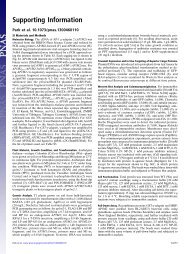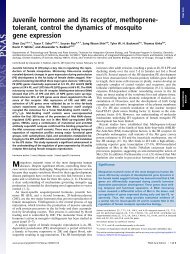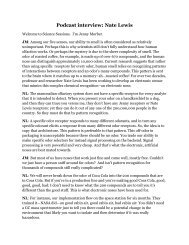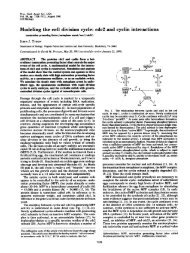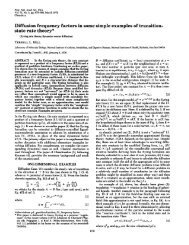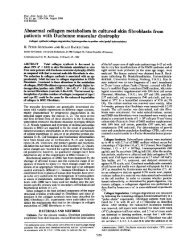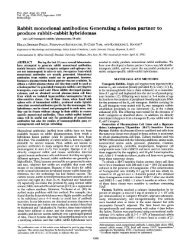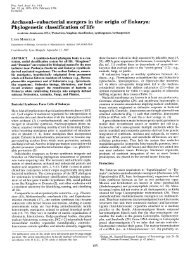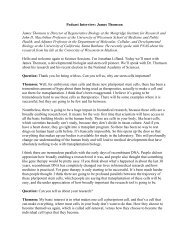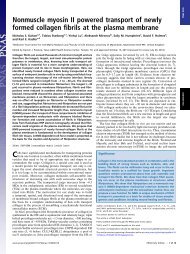Supporting Information
Supporting Information
Supporting Information
You also want an ePaper? Increase the reach of your titles
YUMPU automatically turns print PDFs into web optimized ePapers that Google loves.
Table S3. Cross-cultural congruence in plant use in hot nodes<br />
%totalflora included % medicinal hits<br />
% gain in medicinal hits included<br />
compared with random<br />
Significance in<br />
gain (P value)<br />
Medicinal floras 21.97 25.62 16.65 0.2657<br />
Cardiovascular/blood purity 10.73 16.43 53.14 0.0673<br />
Dentistry/mouth 27.78 32.87 18.33 0.2015<br />
Gastrointestinal 15.39 21.35 38.77 0.0822<br />
General 29.41 26.18 −10.99 N/A<br />
Gynecology/fertility 30.81 32.43 5.25 0.4355<br />
Musculoskeletal 12.78 18.50 44.70 0.0833<br />
Neurology 25.95 33.68 29.80 0.0701<br />
Ophthalmology 10.59 21.01 98.33 0.0017<br />
Other 22.13 30.95 39.84 0.0415<br />
Otorhinolaryngology 14.59 25.92 77.61 0.0043<br />
Respiratory/pulmonary 14.81 19.72 33.17 0.1493<br />
Skin 25.03 31.50 25.87 0.1049<br />
Urinary 13.50 18.42 36.43 0.1230<br />
Average categories 19.50 25.30 37.71 0.1057<br />
Figures are the average from the six tests to investigate the extent to which hot nodes of each region (source region) can predict the medicinal plant use in<br />
the other two regions (target regions). The first column of data shows the percentage of the total flora of the target regions included in the hot nodes of the<br />
source region, using the option “nodesig” in PHYLOCOM v4.1. The second column shows the percentage of medicinal plants of the target regions found in<br />
those nodes. The third column shows the percentage of gain in medicinal hits achieved by sampling those nodes, compared with random sampling. Results are<br />
summarized for the medicinal floras of Nepal, New Zealand, and the Cape of South Africa, and for 13 categories of conditions. P value in bold is the one that<br />
remains significant after a Bonferroni correction of the α-significance level. Note that in uncorrected data, 1/20 significant comparisons may be spurious (type I<br />
errors), but the Bonferroni correction adjusts the α-threshold so the study-wide error rate remains at 0.05. N/A, not applicable<br />
Table S4. Similarities between the floras of Nepal, New Zealand,<br />
and the Cape of South Africa based on the Sørensen Index (ref. 1)<br />
at the genus level<br />
Region Nepal New Zealand Cape of South Africa<br />
Nepal 1<br />
New Zealand 0.28 1<br />
Cape of South Africa 0.37 0.34 1<br />
1. Sørensen T (1948) A method of establishing groups of equal amplitude in plant sociology based on similarity of species and its application to analyses of the vegetation on Danish<br />
commons. Biol Skr 5:1–34.<br />
Table S5. Significance of agreement in lineages used between<br />
pairs of medicinal floras when genera used in more than one<br />
region are removed<br />
Region Nepal Cape of South Africa New Zealand<br />
Nepal —<br />
Cape of South Africa P < 0.001 —<br />
New Zealand P = 0.005 P = 0.021 —<br />
Significance was assessed by comparing observed values of pair-wise distances<br />
to those from 10,000 random comparisons per case and P values were<br />
the frequency of randomizations with smaller pair-wise distance.<br />
Saslis-Lagoudakis et al. www.pnas.org/cgi/content/short/1202242109 6of25



